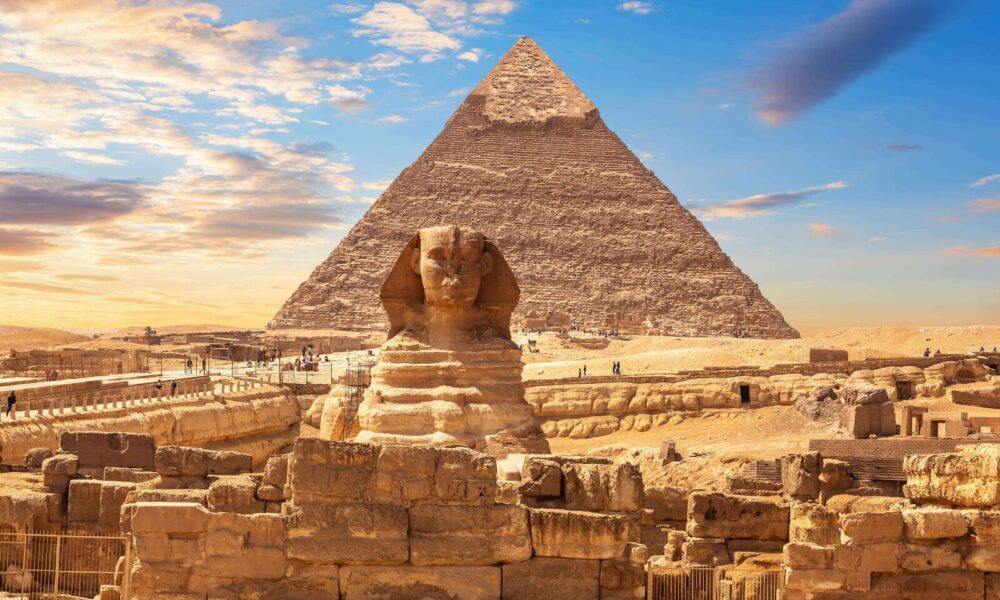Exploring the Pyramid of Giza: A Journey Through Ancient Egypt

The Pyramid of Giza stands as a powerful symbol of ancient Egypt’s grandeur, drawing millions of visitors each year to marvel at its scale and mystery. As the oldest and only surviving wonder of the Seven Wonders of the Ancient World, the pyramid is a testament to the ingenuity, ambition, and spiritual beliefs of the ancient Egyptians. Located on the Giza Plateau, just outside modern-day Cairo, the Pyramid of Giza offers a glimpse into a civilization that shaped human history.
A Monument to Pharaoh Khufu
The Pyramid of Giza, also known as the Great Pyramid, was constructed around 2560 BCE as a tomb for Pharaoh Khufu, one of the rulers of Egypt’s Fourth Dynasty. Designed to ensure the pharaoh’s safe passage to the afterlife, it was the centerpiece of a grand funerary complex that included temples, smaller pyramids, and various ceremonial structures. At its completion, the pyramid stood 146 meters (481 feet) tall, making it the tallest human-made structure for nearly 4,000 years.
Pharaoh Khufu’s decision to build such a monumental tomb reflected his power and the religious importance of the afterlife in ancient Egypt. The pyramid’s massive size and perfect alignment with the cardinal points were meant to symbolize the connection between earth and the heavens. Even today, the Pyramid of Giza remains a powerful symbol of eternity and divine authority.
Architectural Marvel and Engineering Feat
The construction of the Pyramid of Giza is a remarkable engineering accomplishment, especially considering the limited tools and technology available at the time. It is estimated that about 2.3 million limestone and granite blocks were used in its construction, with each block weighing between 2.5 and 80 tons. Despite the lack of modern machinery, the ancient Egyptians managed to build a structure of extraordinary precision and durability.
The pyramid’s sides are aligned almost perfectly with the cardinal directions—north, south, east, and west. This precise orientation demonstrates the advanced knowledge of astronomy and mathematics possessed by ancient Egyptian architects. Inside the pyramid, a series of narrow passageways and chambers leads to the King’s Chamber, which was built with massive granite blocks transported from quarries hundreds of kilometers away. The complexity and accuracy of the internal design continue to astonish researchers and architects today.
Theories and Mysteries of Construction
How the ancient Egyptians built the Great Pyramid has been a topic of debate for centuries. Numerous theories have been proposed, ranging from the use of straight and spiral ramps to more advanced lifting mechanisms. Scholars have suggested that a combination of these methods was likely used, but no definitive answer has been found.
Recent discoveries, such as the ancient papyri found at Wadi al-Jarf, have provided new insights into the logistics behind the construction. These ancient documents describe how massive limestone blocks were transported along the Nile and then hauled to the construction site. Despite these revelations, many aspects of the pyramid’s construction remain a mystery, adding to its allure and enduring fascination.
The Giza Plateau: A Complex of Wonders
The Pyramid of Giza is part of a larger archaeological site on the Giza Plateau, which includes two other major pyramids—those of Khafre and Menkaure—as well as the iconic Great Sphinx. Each structure has its own unique features and contributes to the overall significance of the site. The Pyramid of Khafre, although slightly smaller than Khufu’s pyramid, appears taller due to its position on higher ground. The Pyramid of Menkaure, the smallest of the three, is notable for its elegant design and the use of granite casing stones.
The Great Sphinx of Giza, a massive statue with the body of a lion and the head of a pharaoh, is one of the most mysterious monuments in the world. Thought to represent Pharaoh Khafre, the Sphinx has stood guard over the plateau for millennia. Its purpose and origin have sparked numerous theories, ranging from it being a guardian of sacred spaces to a symbol of royal power and protection.
Modern-Day Tourism and Exploration
Visiting the Pyramid of Giza is a once-in-a-lifetime experience for many travelers. The site is open to the public, allowing visitors to walk around the pyramid and explore its interior chambers. Guided tours provide valuable insights into the history, construction, and cultural significance of the pyramid, making the experience even more enriching.
The best time to visit is during the cooler months between November and February, when the weather is more comfortable for outdoor exploration. In addition to the pyramids, visitors can explore the nearby Solar Boat Museum, which houses a reconstructed wooden boat believed to have been used in the pharaoh’s funerary rites.
Preservation and Challenges
Preserving the Pyramid of Giza is an ongoing challenge due to natural erosion, environmental factors, and the impact of tourism. Over the centuries, the structure has faced threats from earthquakes, looting, and modern development. Today, both the Egyptian government and international organizations are working to protect and conserve this ancient wonder for future generations.
Modern technology, such as 3D mapping and thermal imaging, has become a vital tool in monitoring the pyramid’s condition and identifying areas in need of restoration. These efforts aim to ensure that the Pyramid of Giza continues to stand as a symbol of human achievement for centuries to come.
The Mysteries of the Pyramid of Giza Unveiled
The Pyramid of Giza has stood as a testament to human ingenuity for over 4,500 years, captivating historians, archaeologists, and travelers alike. As the oldest and only surviving structure of the Seven Wonders of the Ancient World, it remains a source of fascination. This monumental structure, located on the Giza Plateau near Cairo, Egypt, is more than just an ancient tomb. It’s a symbol of mystery and historical grandeur, with its secrets still puzzling modern scholars.
A Glimpse into the Ancient World
The Pyramid of Giza, also known as the Great Pyramid, was constructed around 2560 BCE during the reign of Pharaoh Khufu. It was designed as his final resting place and part of a larger funerary complex that included temples, smaller pyramids for family members, and the Great Sphinx. At its completion, the pyramid stood 146 meters (481 feet) tall, making it the tallest human-made structure in the world for nearly 4,000 years.
Its significance extends beyond its sheer size. The pyramid symbolizes the ancient Egyptians’ profound belief in the afterlife and the power of their rulers. For them, building such a monumental structure was not just an architectural feat but a spiritual endeavor to ensure the pharaoh’s journey to eternity.
Architectural Perfection and Precision
The Pyramid of Giza is renowned for its architectural brilliance and mathematical precision. It consists of approximately 2.3 million limestone and granite blocks, some weighing up to 80 tons. The precision with which these stones were cut, transported, and assembled continues to astonish modern engineers. The four sides of the pyramid align almost perfectly with the cardinal points of the compass—north, south, east, and west—demonstrating the ancient Egyptians’ advanced understanding of astronomy and geometry.
Inside the pyramid lies a complex network of narrow passageways and chambers. The most significant chambers include the King’s Chamber, Queen’s Chamber, and the Grand Gallery. The King’s Chamber, constructed from red granite blocks, houses the sarcophagus of Pharaoh Khufu. The Grand Gallery is an impressive corridor that leads to the King’s Chamber, with its corbelled ceiling showcasing remarkable craftsmanship.
Theories and Unanswered Questions
Despite extensive studies, many aspects of the Great Pyramid’s construction remain a mystery. One of the most debated topics is how the ancient Egyptians managed to move and position such massive stones with precision. Theories range from the use of straight ramps to spiral ramps and even advanced machinery, but no definitive explanation has been found.
Another enduring mystery is the purpose of the internal shafts and voids discovered within the pyramid. Some experts believe they were ventilation systems, while others suggest they had ceremonial or astronomical significance. Recent technological advances, such as thermal imaging and cosmic-ray scanning, have revealed previously unknown cavities, sparking renewed speculation about hidden chambers and undiscovered secrets.
Astronomical and Spiritual Significance
The pyramid’s design is closely tied to ancient Egyptian beliefs and their connection to the stars. Scholars believe that the pyramid may have served as a spiritual gateway for the pharaoh’s soul to ascend to the heavens. The internal shafts align with specific stars, such as Orion’s Belt, which was associated with the god Osiris, the ruler of the afterlife.
The pyramid’s celestial alignment and precise construction reflect the Egyptians’ deep understanding of the cosmos. Some researchers argue that the entire structure was built to mirror the heavens, linking the earthly realm with the divine. This spiritual significance has fueled countless theories and added to the pyramid’s enduring allure.
The Great Sphinx and Other Mysteries
Adjacent to the Pyramid of Giza stands the enigmatic Great Sphinx, a colossal limestone statue with the body of a lion and the head of a pharaoh, believed to be Khafre. The Sphinx has been a subject of debate for centuries. Its purpose and origin remain unclear, with some suggesting it served as a guardian of the Giza Plateau, while others believe it holds hidden chambers beneath its paws.
The surrounding pyramids of Khafre and Menkaure also contribute to the complex’s mystery. These smaller pyramids, along with various temples and tombs, form a vast necropolis that sheds light on ancient Egyptian rituals and burial practices. However, many questions about their construction and exact functions remain unanswered.
Modern Discoveries and Preservation Efforts
In recent years, modern technology has helped unveil new aspects of the Pyramid of Giza. Advanced tools such as 3D mapping, thermal imaging, and cosmic-ray scanning have revealed hidden voids and provided deeper insights into the pyramid’s internal structure. These discoveries have not only reignited interest in the pyramid but also emphasized the importance of preserving it for future generations.
Conservation efforts by the Egyptian government and international organizations are crucial in protecting this ancient wonder. Environmental factors, human activity, and time have taken a toll on the structure, making preservation an ongoing challenge. Thanks to modern science, researchers are now better equipped to monitor the pyramid’s condition and ensure its survival.
A Timeless Legacy
The Pyramid of Giza continues to inspire awe and curiosity, standing as a symbol of ancient Egypt’s greatness and enduring legacy. It has captivated people for millennia, drawing millions of visitors each year. For many, visiting the pyramid is a dream come true—a chance to connect with the distant past and experience one of the world’s most remarkable achievements.
Despite centuries of study, the Great Pyramid remains shrouded in mystery. Its secrets may never be fully unveiled, but that is part of its charm. The mysteries of the Pyramid of Giza are a reminder of the incredible capabilities of ancient civilizations and the timeless allure of the unknown.






